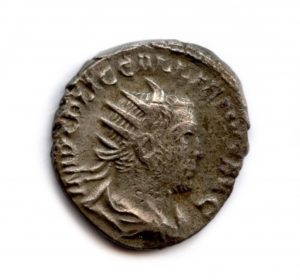

Silver Antoninianus of Gallienus (253-268), minted in Viminacium (Moesia), 256 CE
Diameter: 2 cm
Description
Obverse:
IMP C P LIC GALLIENVS AVG
(Imperator Caesar Publius Licinius Gallienus Augustus)
Bust of Gallienus facing right, wearing radiate crown and a cloak covering his shoulders.
Reverse:
[PACA]TORI ORBIS
(Pacatori Orbis)
Jupiter, facing left, seated on a throne. In his left hand, he holds a scepter. In his right hand, he holds a patera (shallow dish used for pouring libations). An eagle stands at his foot.
Other notes: Only about a quarter of the dotted ring border can be seen on the obverse and no border can be seen on the reverse. Instead of wear and tear, this is most likely because insufficient material was used during the striking process.
Commentary
Many of our observations about this coin are based on other examples of the same type, RIC V Gallienus 294, with details better preserved. This coin was struck in 256 CE, during the joint reign of Gallienus and his father, Valerian. Among all the coin types listed in the Wildwinds collectors’ database featuring Gallienus, this is the only one with Jupiter holding a patera and “acatori orbis” as the reverse legend (Kurth).
As the father of all deities in Roman mythology, Jupiter was featured prominently in imperial numismatic imagery. Twenty emperors who ruled during the third century referenced Jupiter on their coins (Manders 2012, 103, fig. 19). Common attributes that appear with Jupiter include an eagle, Victory, his thunderbolt, and a scepter. On this coin, the identifying element is the eagle in the bottom left corner. The divine association formed by visually connecting Gallienus with Jupiter is an essential part of the emperor’s propaganda. To the citizens of Rome, it thus conveyed the message that the legitimacy of Gallienus’s rule was endowed by the chief god. Along with the appellation “PACATORI ORBIS” (see below) the image of Jupiter also bears military undertones. Although pacator means a guardian of peace, the joint reign of Valerian and Gallienus was fraught with invasions and revolts. Hence, a more appropriate interpretation of pacator should connect it with victorious warfare instead of a period of harmony. The image of Jupiter thus denotes his expected assistance in a multitude of military campaigns (Manders 2012, 106-107, 284).
The obverse legend gives the full name of the emperor, Publius Licinius Gallienus, and his honorary titles. Imperator meant leader of the army in Rome, thus denoting Gallienus was a proud military leader and built a strong and powerful persona (Smith 1998). The C is short for Caesar and AVG is short for Augustus, both titles given to the members of the imperial family (Smith 1998).This is further supported by the inscription on the reverse, “Pacatori orbis,” meaning “For the peace-maker of the world.” Pacatori is the dative singular form of pacator meaning “peace-maker,” and the dative form implies tribute “to/for.” Orbis is genitive singular and means “of the world.” In one way, the legend expresses Gallienus’s thanks to Jupiter as maker of peace in the world; but since Gallienus is implicitly assimilated with Jupiter, it also alludes to the scope of Gallienus’s conquests, whether real or hoped for. The title of pacator orbis had first been given to Septimus Severus after conquering and making peace with the Parthians. This title was then given to succeeding emperors with hopes of them having the same ability and impact as the original peace-maker of the world (Stevenson 1889, 593). Although Gallienus did have some military success, they were not nearly as great as this legend suggests. Without consistent news sources across the empire, coins could send exaggerated messages of imperial propaganda.
Interestingly, this coin type is nearly identical to one issued by Valerian (RIC Valerian V 218) one year earlier, from the same mint (Viminacium in the province of Moesia, modern Serbia, see 1979.11.147 in this exhibition). The duplication of the imagery as well as the legend may have been intended to send a message of unity between father and son co-rulers.
Works cited:
Kurth, Dane. n.d. “Browsing Roman Imperial Coins of Gallienus.” WildWinds. Accessed December 1, 2020. https://www.wildwinds.com/coins/ric/gallienus/i.html
Manders, Erika. 2012. Coining Images of Power: Patterns in the Representation of Roman Emperors on Imperial Coinage, A.D. 193-284. Leiden: Brill. https://doi.org/10.1163/9789004224001_005.
OCRE. Online Coins of the Roman Empire, American Numismatic Society. http://numismatics.org/ocre/
Smith, Doug. 1998. “Abbreviations on Roman Imperial Coins.” Forum Ancient Coins. Accessed December 1, 2020. https://www.forumancientcoins.com/dougsmith/abb.html
Stevenson, Seth William. 1889. A Dictionary of Roman Coins, Republican and Imperial. London: G. Bell and Sons. Accessed on Forum Ancient Coins, d December 7, 2020.https://www.forumancientcoins.com/numiswiki/view.asp?key=dictionary%20of%20roman%20coins
Coin type: RIC V Gallienus (joint reign) 294
Research by: Will King, Class of 2024; Adrian Zhou, Class of 2022